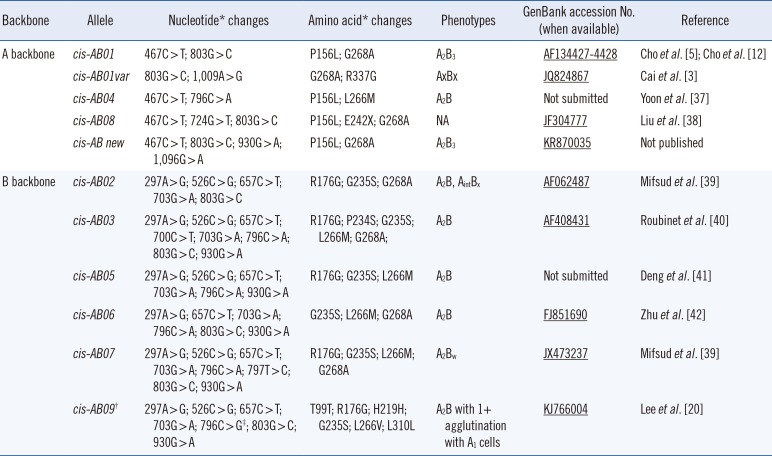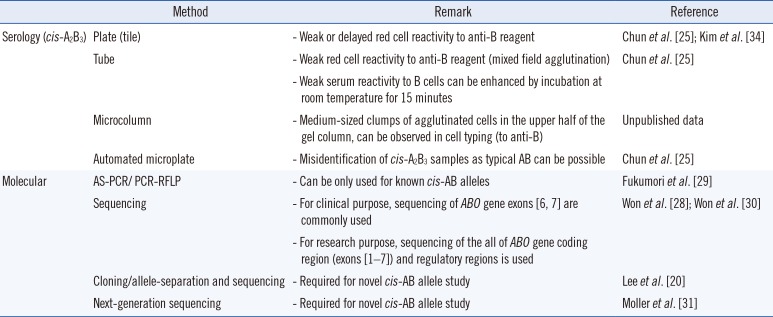1. Blumenfeld OO, Patnaik SK. Allelic genes of blood group antigens: a source of human mutations and cSNPs documented in the Blood Group Antigen Gene Mutation Database. Hum Mutat. 2004; 23:8–16. PMID:
14695527.
2. Olsson ML, Irshaid NM, Hosseini-Maaf B, Hellberg A, Moulds MK, Sareneva H, et al. Genomic analysis of clinical samples with serologic ABO blood grouping discrepancies: identification of 15 novel A and B subgroup alleles. Blood. 2001; 98:1585–1593. PMID:
11520811.
3. Cai X, Jin S, Liu X, Fan L, Lu Q, Wang J, et al. Molecular genetic analysis of ABO blood group variations reveals 29 novel ABO subgroup alleles. Transfusion. 2013; 53:2910–2916. PMID:
23521133.
4. Ogasawara K, Yabe R, Uchikawa M, Saitou N, Bannai M, Nakata K, et al. Molecular genetic analysis of variant phenotypes of the ABO blood group system. Blood. 1996; 88:2732–2737. PMID:
8839869.
5. Cho D, Kim SH, Jeon MJ, Choi KL, Kee SJ, Shin MG, et al. The serological and genetic basis of the
cis-AB blood group in Korea. Vox Sang. 2004; 87:41–43. PMID:
15260821.
6. Yamaguchi H. A review of
cis-AB blood. Jinrui Idengaku Zasshi. 1973; 18:1–9. PMID:
4585341.
7. Jin S, Cai X, Liu X, Wang J, Lu Q, Shen W, et al. Study on cis-AB and B (A) subgroups in Shanghai blood donors, China. Chin J Blood Transfus. 2013; 26:1198–1201.
8. Yazer MH, Olsson ML, Palcic MM. The
cis-AB blood group phenotype: fundamental lessons in glycobiology. Transfus Med Rev. 2006; 20:207–217. PMID:
16787828.
9. Yoshida A. Genetic mechanism of blood group (ABO)-expression. Acta Biol Med Ger. 1981; 40:927–941. PMID:
6800172.
10. Yoshida A, Yamaguchi H, Okubo Y. Genetic mechanism of
cis-AB inheritance. II. Cases associated with structural mutation of blood group glycosyltransferase. Am J Hum Genet. 1980; 32:645–650. PMID:
6775529.
11. Yoshida A, Yamaguchi H, Okubo Y. Genetic mechanism of
cis-AB inheritance. I. A case associated with unequal chromosomal crossing over. Am J Hum Genet. 1980; 32:332–338. PMID:
6770676.
12. Cho D, Kee SJ, Shin JH, Suh SP, Ryang DW. Unusual phenotype of
cis-AB. Vox Sang. 2003; 84:336–337. PMID:
12757512.
13. Cho D, Kim SH, Ki CS, Choi KL, Cho YG, Song JW, et al. A novel
Bvar allele (547 G>A) demonstrates differential expression depending on the co-inherited ABO allele. Vox Sang. 2004; 87:187–189. PMID:
15569071.
14. Kim DW, Cho D, Yazer MH, Lee HJ, Kim KH, Shin MG, et al. A novel A subtype allele that demonstrates allelic competition. Ann Clin Lab Sci. 2011; 41:282–284. PMID:
22075514.
15. Whang DH, Shin BM, Lee HS, Hur M, Han BY, Han KS. Unusual phenotype expression in a cis-AB trait: cis-AB child from a group A father and a group O mother. Korean J Blood Transfus. 2000; 11:169–175.
16. Kang SH, Lee YK, Park MJ, Shin DH, Cho HC, Lee KM, et al. A case of cis-AB without B antigen expression. Korean J Blood Transfus. 2001; 12:245–251.
17. Song EY, Jeon DS, Seo DH, Han KS. A case of cis-AB child from a group O father and a group A mother. J Clin Pathol Qual Control. 2001; 23:325–329.
18. Patnaik SK, Helmberg W, Blumenfeld OO. BGMUT database of allelic variants of genes encoding human blood group antigens. Transfus Med Hemother. 2014; 41:346–351. PMID:
25538536.
19. Yamamoto F, McNeill PD, Kominato Y, Yamamoto M, Hakomori S, Ishimoto S, et al. Molecular genetic analysis of the ABO blood group system: 2.
cis-AB alleles. Vox Sang. 1993; 64:120–123. PMID:
8456556.
20. Lee SY, Phan MT, Shin DJ, Shin MG, Park JT, Shin JW, et al. A novel
cis-AB variant allele arising from a
de novo nucleotide substitution c.796A>G (p.M266V) in the B glycosyltransferase gene. Transfus Med. 2015; 25:333–336. PMID:
26197879.
21. Pacuszka T, Koscielak J, Seyfried H, Walewska I. Biochemical, serological and family studies in individuals with cis AB phenotypes. Vox Sang. 1975; 29:292–300. PMID:
807040.
22. Cho D, Yang SJ, Park MR, Suh SP, Jeon MJ, Seo DH, et al. Phenotype and genotype of cis-AB family Chonnam area. Korean J Blood Transfus. 2002; 13:127–134.
23. Yamaguchi H, Okubo Y, Tanaka M. “
Cis-AB” bloods found in Japanese families. Jinrui Idengaku Zasshi. 1970; 15:198–215. PMID:
5534919.
24. Woo CM, Lee HJ, Kwak H, Shin SW, Kwon JY, Kim HK. Mismatched transfusion reaction in cis-AB: a case report. Korean J Anesthesiol. 2006; 51:632–637.
25. Chun S, Ryu MR, Cha SY, Seo JY, Cho D. ABO mistyping of
cis-AB blood group by the automated microplate technique. Transfus Med Hemother. 2018; 45:5–10. PMID:
29593455.
26. Park MS, Chun S, Lee CH, Cho D. Diverse phenotypes of cis-AB blood group and transfusion strategy. Korean J Blood Transfus. 2016; 27:304–306.
27. Cho D, Lee JS, Park JY, Jeon MJ, Song JW, Kim SH, et al. Resolution of ABO discrepancies by ABO genotyping. Korean J Lab Med. 2006; 26:107–113. PMID:
18156710.
28. Won EJ, Cho D, Heo MS, Park HR, Shin MG, Ryang DW. Six years' experience performing ABO genotyping by PCR-direct sequencing. Korean J Blood Transfus. 2012; 23:236–247.
29. Fukumori Y, Ohnoki S, Yoshimura K, Nagao N, Shibata H, Tomita T, et al. Rapid detection of the
cis-AB allele consisting of a chimera of normal A and B alleles by PCR-RFLPs. Transfus Med. 1996; 6:337–344. PMID:
8981729.
30. Won EJ, Park G, Cho D, Lim AH, Kweon SY, Kweon SS, et al. Complete sequencing of the ABO alleles of the common ABO group and rare ABO subgroups in Koreans. Korean J Blood Transfus. 2012; 23:1–12.
31. Moller M, Joud M, Storry JR, Olsson ML. Erythrogene: a database for in-depth analysis of the extensive variation in 36 blood group systems in the 1000 Genomes Project. Blood Adv. 2016; 1:240–249. PMID:
29296939.
32. Kawahito S, Kitahata H, Kimura H, Tanaka K, Oshita S. Autotransfusion performed on a patient with
cis AB blood group. Br J Anaesth. 1999; 83:491–492. PMID:
10655930.
33. Kang BJ. An anesthetic experience of a patient with cis-A2B3 blood type. Korean J Anesthesiol. 2001; 40:95–99.
34. Oh E, Lee H, Park Y, Lim HS. A transfusion experience for a patient with cis-A2B3 phenotype. Korean J Blood Transfus. 2010; 21:154–157.
35. Korea Centers for Disease Control and Prevention. Korean National Transfusion Guideline. 4th ed. Osong: Korea Centers for Disease Control and Prevention;2016. p. 15–16.
36. Yoon SZ, Lee HM, Kim HS, Kim SD, Oh AY, Kim CS. Transfusion for a patient of
cis-AB blood type undergoing a redo cardiac operation. Br J Anaesth. 2005; 94:733–734. PMID:
15749736.
37. Yoon J, Youk HJ, Chang JH, Jang MA, Choi JH, Nam MH, et al. Identification of the ABO*
cis-AB04 allele with a unique substitution C796A: the first case in Korea. Ann Lab Med. 2016; 36:620–622. PMID:
27578521.
38. Liu YC, Ma L, Zhang DM, Zheng L, Liu Y, Wu MH, et al. The serological and genetic identification of a
cis-AB blood sample. Zhonghua Yi Xue Yi Chuan Xue Za Zhi. 2011; 28:552–554. PMID:
21983733.
39. Mifsud NA, Watt JM, Condon JA, Haddad AP, Sparrow RL. A novel
cis-AB variant allele arising from a nucleotide substitution A796C in the B transferase gene. Transfusion. 2000; 40:1276–1277. PMID:
11061869.
40. Roubinet F, Janvier D, Blancher A. A novel
cis-AB allele derived from a B allele through a single point mutation. Transfusion. 2002; 42:239–246. PMID:
11896341.
41. Deng ZH, Seltsam A, Ye YW, Yu Q, Li Q, Su YQ, et al. Haemolytic disease of fetus and newborn caused by ABO antibodies in a
cis-AB offspring. Transfus Apher Sci. 2008; 39:123–128. PMID:
18793871.
42. Zhu Z, Ye L, Li Q, Gao H, Tan Y, Cai W. Red cell immunohematology research conducted in China. Transfus Med Rev. 2017; 31:102–106. PMID:
28017498.







 PDF
PDF ePub
ePub Citation
Citation Print
Print




 XML Download
XML Download